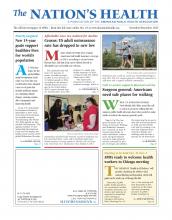While U.S. obesity rates have mostly held steady, nearly half of all states still have rates of 30 percent or more, according to a recent report.
“The State of Obesity 2015: Better Policies for a Healthier America” annual report, released in September, noted that from 2011-2012, 17 percent of youth ages 2 to 19 and more than 34.9 percent of adults were obese. U.S. obesity rates have begun to stabilize overall in recent years, but still fall short of U.S. goals.
The report, released by Trust for America’s Health and the Robert Wood Johnson Foundation, affirms that the obesity epidemic is one of the biggest threats to the nation’s health. In 2014, 22 states had adult obesity rates higher than 30 percent, 45 states had rates over 25 percent and every state had rates greater than 20 percent. In 1980, no state was above 15 percent in adult obesity and in 2000 no state was higher than 25 percent. In 2007, the only state above 30 percent was Mississippi.
“Efforts to prevent and reduce obesity over the past decade have made a difference,” said Jeffrey Levi, PhD, executive director of Trust for America’s Health, in a Sept. 21 news release. “Stabilizing rates is an accomplishment. However, given the continued high rates, it isn’t time to celebrate. We’ve learned that if we invest in effective programs, we can see signs of progress. But we still haven’t invested enough to really tip the scales yet.”
The states with the highest rate of obesity were in the South and the Midwest, according to the report. Three states surpassed 35 percent in adult obesity rates: Arkansas, at 35.9 percent; West Virginia, at 35.7 percent; and Mississippi, at 35.5 percent. The lowest rates in the U.S. were Colorado, at 21.3 percent; the District of Columbia, at 21.7 percent; and Hawaii, at 22.1 percent.
According to the report, more than 8 percent of children ages 2 to 5 were obese and 48 percent of children under age 3 lived in low-income neighborhoods, putting them at a higher risk for obesity. While obesity can put children at risk for chronic conditions such as Type 2 diabetes, it can also take a toll on their school performance, the report showed. Compared to their average-weight peers, overweight and obese children were more likely to have lower academic achievement, according to the report. The report also showed that poor scores in math are seen as early as first grade for overweight and obese children compared to peers with healthier weights.
Programs are available for low-income families with infants and children who are at risk for poor nutrition. The Special Supplemental Nutrition Program for Women, Infants, and Children provides low-income pregnant, postpartum and breastfeeding women and children up to age 5 with nutritious foods, nutrition education and health and social services. The Head Start program aids low-income families with children ages 3 to 5, with nutrition, education, social services and school readiness assistance.
States and schools are also taking action to help Americans become healthy and stay fit. Tennessee public schools, for example, are implementing obesity prevention efforts via the state Department of Education’s Office of Coordinated School Health, the report noted.
To create healthy schools in their state, more than half of Tennessee schools stopped selling soda or juice that was not 100-percent fruit in 2012, compared with 27 percent of schools in 2006. Additionally, in 2007, Tennessee public schools required students to participate in 90 minutes of physical activity per week. By the end of the 2013-14 school year, almost two-thirds of all school districts went beyond the minimum 90 minutes, the report said. The implementation of obesity prevention efforts led to a 6.3 percent decline in overweight and obese students in kindergarten and second, fourth, sixth and eighth grades as well as among high school students.
“In order to build a national culture of health, we must help all children, no matter who they are or where they live, grow up at a healthy weight,” said Risa Lavizzo-Mourey, MD, MBA, president and CEO of the Robert Wood Johnson Foundation in the Sept. 21 news release. “We know that when we take comprehensive steps to help families be more active and eat healthier foods, we can see progress. Now we must extend those efforts and that progress to every community in the country.”
For information, visit http://stateofobesity.org.
- Copyright The Nation’s Health, American Public Health Association









